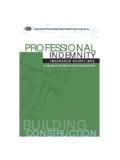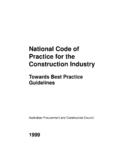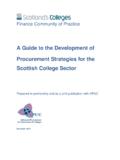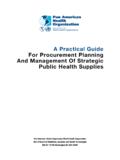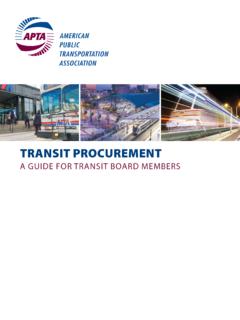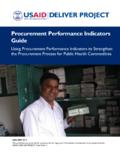Transcription of Building and Construction Procurement Guide …
1 The Building and Construction Procurement Guide consolidates Australian government approaches to procuring and contracting civil (road and bridge) and non-residential Building works and services into a single overarching Guide defines methods, processes and principles designed to reduce inconsistency in approaches to Procurement and contracting, and responds to issues raised by and Construction Procurement GuidePrinciples and OptionsBuilding and Construction Procurement Guide - Principles and OptionsAustroads is the association of Australian and New Zealand road transport and traffic Australasian Procurement and Construction Council (APCC) is the peak body for government Building and Construction policy in Australia and New Zealand. Building and Construction Procurement GuidePrinciples and OptionsInformation retrievalAustroads, 2014, Building and Construction Procurement Guide Principles and Options, Sydney, A4, pp.
2 : Harmonisation, Procurement , tender, Procurement strategy, delivery model, contract, risk allocation, Building , Construction , professional services, Building information : The Building and Construction Procurement Guide Principles and Options ( the Guide ) consolidates current jurisdiction-specific approaches to Procurement and contracting of civil (road and bridge) and non-residential Building works and services into a single overarching framework. The Guide defines a series of methods, processes and principles that have been designed to reduce inconsistency in member agencies approaches to Procurement and contracting, and responds to a variety of issues raised by Published 2014 Austroads Ltd 2014 This work is copyright. Apart from any use as permitted under the Copyright Act 1968, no part may be reproduced by any process without the prior written permission of 978-1-925037-19-7 Austroads Project No: TO1641 Austroads publications number AP-G92-14 Project ManagerPeter Bamford, Roads and Maritime Services NSWP repared byElisa Casey ARRB Group Ltd and Peter Bamford, NSW Roads and Maritime ServicesAcknowledgementsParticular sections of this Guide are derived from the Western Australian Government s Centre for Excellence and Innovation in Infrastructure Delivery Infrastructure Procurement options Guide (2010).
3 Permission to utilise this document is gratefully acknowledged. Austroads and the APCC would also like to thank Peter Barda, Executive Director of the Australian Construction Industry Forum, for his contribution to Section 7 of the Guide . Published by Austroads LtdLevel 9 Robell House287 Elizabeth StreetSydney NSW 2000 AustraliaPhone: +61 2 9264 7088 Fax: +61 2 9264 1657 Email: believes this publication to be correct at the time of printing and does not accept responsibility for any consequences arising from the use of information herein. Readers should rely on their own skill and judgement to apply information to particular Austroads purpose is to: promote improved Australian and New Zealand transport outcomes provide expert input to national policy development on road and road transport issues promote improved practice and capability by road agencies promote consistency in road and road agency MembershipAustroads membership comprises the six state and two territory road transport and traffic authorities, the Commonwealth Department of Infrastructure and Regional Development, the Australian Local Government Association, and NZ Transport Agency.
4 Austroads is governed by a Board consisting of the chief executive officer (or an alternative senior executive officer) of each of its eleven member organisations: Roads and Maritime Services, New South Wales Roads Corporation, Victoria (VicRoads) Department of Transport and Main Roads, Queensland Main Roads Western Australia Department of Planning, Transport and Infrastructure, South Australia Department of Infrastructure, Energy and Resources, Tasmania Department of Transport, Northern Territory Department of Territory and Municipal Services, Australian Capital Territory Commonwealth Department of Infrastructure and Regional Development Australian Local Government Association New Zealand Transport success of Austroads is derived from the collaboration of member organisations and others in the road industry. It aims to be the Australasian leader in providing high quality information, advice and fostering research in the road Procurement and Construction CouncilThe Australasian Procurement and Construction Council Inc (APCC) is the peak body whose members are responsible for Procurement , Construction and asset management policy for the Australian, State and Territory Governments and the New Zealand Government.
5 Papua New Guinea is an associate member. The APCC is made up of 14 member the last 35 years, the APCC has established itself as a leader in government Procurement . It has championed innovation and harnessed the benefits of nationally consistent approaches for its members. Through the collective expertise and open exchange of information between individual members, the APCC is at the forefront of developing strategies and directions that balance the complex and divergent Procurement work of the APCC is directed towards Procurement and Construction innovation, solutions and efficiencies which can create savings and maximise service delivery to the communities of Australia, New Zealand and Papua New Membership Department of Finance and Services, New South Wales Department of Finance, Western Australia Department of Treasury, Western Australia Department of Planning, Transport and Infrastructure, South Australia Department of Treasury and Finance, South Australia Ministry of Business, Innovation and Employment, New Zealand Department of Treasury and Finance.
6 Victoria Department of Housing and Public Works, Queensland Australian Department of Finance and Deregulation Australian Defence Materiel Organisation Department of Business, Northern Territory Department of Infrastructure, Northern Territory Commerce and Works Directorate, Australian Capital Territory Central Supply and Tenders Board, Papua New by Austroads and the APCCA ustroads and the Australasian Procurement and Construction Council (APCC) are pleased to support the release of the Building and Construction Procurement Guide Principles and Options. This Guide has been custom-designed for use by Australian state and territory agencies in the civil (road and bridge) and non-residential Building sectors. Representatives from industry and all relevant member agencies provided input into its content. While our two sectors operate in different landscapes, and each has its own unique issues to manage, there are also many common challenges that can be overcome by working collaboratively.
7 By coming together to develop the Guide , Austroads and the APCC have clearly demonstrated the level of progress toward harmonisation and problem-solving that can be achieved through goodwill and cooperation. The Guide will help project owners to develop Procurement strategies that respond to the needs of individual projects. While some member agencies already have guidelines available on this topic, there are certain divergences in approach. The Guide addresses this by harmonising terminology, methods and processes currently in use to create an overarching framework for the assessment of Procurement options and development of Procurement strategies that can be added onto as appropriate to ensure that any unique jurisdictional and national requirements are met. The Guide specifically responds to a range of issues raised by industry regarding member agencies Procurement practices and risk allocation in contracts.
8 It includes a range of agreed principles that tackle some of the most difficult topics in the tendering and contracting spheres such as warranties, indemnities, insurances and intellectual property. The principles recognise that while member agencies will continue to use different forms of contract and follow different Procurement processes, there are some fundamental doctrines that can be applied to key issues to ensure a reasonably consistent approach across our two sectors. This, in turn, provides a greater level of certainty to industry and will help drive down the cost of Guide also provides summary information regarding recent developments around the use of interactive and collaborative Procurement processes and project techniques such as Building information modelling. This recognises the raft of positive outcomes that can be achieved by fostering positive relationships with industry and Building provision for teamwork into contracts including improved efficiency, decreased disputes and practical, progressive learnings that can be applied to future projects.
9 This section of the Guide is likely to be expanded in the future as more agencies adopt these techniques and document experiences that can be shared with thank member agencies for their involvement in the development of this Guide and welcome further input from agencies and industry in future Guide reviews and updates as we continue along the path toward greater harmonisation and consistency across the two important sectors we Milazzo Rod Hook Chairperson Chair Austroads APCC CouncilSummaryAustroads and the Australasian Procurement and Construction Council have developed this Building and Construction Procurement Guide Principles and Options ( the Guide ) to consolidate current jurisdiction specific approaches to Procurement and contracting of civil (road and bridge) and non-residential Building works and services into a single overarching framework.
10 The Guide , which has been prepared in response to a request from the Council of Australian Governments Infrastructure Working Group, builds on existing documentation including national guidelines and key jurisdictional documents by merging common aspects and addressing gap areas to define a series of methods, processes and principles recommended for use by member agencies. These methods, processes and principles are focused on reducing current inconsistencies in member agencies practices and responding to a variety of issues raised by industry, particularly with respect to contractual risk , the Guide includes: a range of Procurement options for member agency project owners to consider, to support the delivery of specific projects profiles of relevant delivery models ( construct only, alliance etc.) and associated forms of contract, together with details of typical Procurement processes a recommended process for the development of Procurement strategies for individual projects adapted from the National public private partnership policy and guidelines (Infrastructure Australia 2008), and also broadly consistent with the National alliance contracting policy and guidelines (Department of Infrastructure and Transport 2011) and pre existing jurisdictional guidelines information for project owners considering the use of Building information modelling and other information and communications technology (ICT)-based project techniques agreed common tendering and contracting principles to be adopted by member of the Guide in the assessment of Procurement options and development of Procurement strategies will help to.
